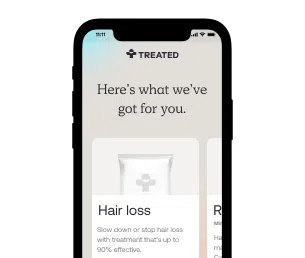Folliculitis
Tailored treatments to clear your follicle infection.
Folliculitis is a common infection where your hair follicles become inflamed and often infected. It can occur anywhere on your body where there is hair.
Got questions about your skin health? We’ve got answers. Order folliculitis treatment online and start your plan as early as the next working day.
Folliculitis is a condition that causes your hair follicles to become inflamed. It can occur as a result of infection, irritation and various skin diseases.
It can affect the hair follicles superficially, or it can be much deeper, causing redness and irritation. An infection is usually behind most cases of folliculitis, but hair follicles can become inflamed because of ingrown hairs, or because of medications that affect the skin, such as cyclosporine and lithium.
Folliculitis is usually confirmed by a clinician who looks at the affected areas of the skin and asks some questions about your symptoms. The condition can affect both men and women, although some fungal strains, such as Malassezia folliculitis, tend to affect men more commonly.
Anyone can get folliculitis. The infection can occur anywhere where pilosebaceous units (the hair shaft, hair follicle and sebaceous gland) are found on your body.
The most common bacterial form of the infection is caused by Staphylococcus aureus, more commonly referred to as Staph.
People who have a history of diabetes, or anyone who is immunocompromised, are at a greater risk of developing this condition. Shaving frequently can also increase your chances of developing folliculitis.
Folliculitis is considered a common infection, but there isn’t much evidence to say how often people are affected by it.
A clinician will usually check to see if any other skin diseases might be causing your itching. You might also be asked whether you’ve used a hot tub or swimming pool recently, as bacterial folliculitis often spreads there.
Common causes of folliculitis include:
Keeping on top of your personal hygiene is a helpful way of preventing folliculitis from recurring once you’ve treated your infection.
If you think your shaving or a skincare routine might be causing it, we’ll recommend adjustments that can reduce damage to your hair follicles.

How we source info.
When we present you with stats, data, opinion or a consensus, we’ll tell you where this came from. And we’ll only present data as clinically reliable if it’s come from a reputable source, such as a state or government-funded health body, a peer-reviewed medical journal, or a recognised analytics or data body. Read more in our editorial policy.
Folliculitis can occur on your body wherever hair grows, and there are lots of things that can cause an infection.
One of the most common places that folliculitis spreads is in hot tubs. Sometimes referred to as pseudomonas folliculitis, this is an infection caused by Pseudomonas aeruginosa, a type of bacteria that can survive in chlorinated water (most bacteria can’t survive in these conditions).
If you’re planning on using a hot tub or jacuzzi, you should make sure it is cleaned regularly to limit your chances of picking up an infection.
You can also develop folliculitis by sharing towels and razors with other people, usually when Staphylococcus aureus (staph) bacteria is present. Most common types of folliculitis don’t spread person-to-person, though.
The severity of folliculitis symptoms can vary, depending on the type of infection you have. The most common symptoms, whether your infection is bacterial, viral, or caused by inflammation, are raised, red bumps on your skin where your follicles are. They look like tiny spots and, sometimes, these raised bumps contain pus.
The bumps can appear anywhere you have hair, but they’re more likely to appear in areas prone to irritation, from repeated rubbing caused by clothes, or damage from shaving.
It’s common for the skin to itch, and sometimes it can be painful. A skin scraping, or swab test, might be necessary if your folliculitis symptoms aren’t responding to standard treatments.
Folliculitis isn’t usually a sign of a more serious condition, and having an infection shouldn’t cause any long-term damage to your skin or general health.
Scratching and itching any skin condition too much can cause infection, so should be avoided. It can also cause scarring if your scratching is severe, so if your urge to itch is persistent, you could look at treatments such as creams or ointments which are designed to soothe irritation.

How we source info.
When we present you with stats, data, opinion or a consensus, we’ll tell you where this came from. And we’ll only present data as clinically reliable if it’s come from a reputable source, such as a state or government-funded health body, a peer-reviewed medical journal, or a recognised analytics or data body. Read more in our editorial policy.
There are lots of treatments available for folliculitis. The one you’re prescribed will depend on the type of infection you have — whether it’s fungal, bacterial, or caused by follicle damage and inflammation (caused by things like shaving or skin rubbing).
Oral and topical antibiotics are used for bacterial infections, and antifungal tablets and creams are used to treat fungal folliculitis. Acne treatments can also help to ease skin irritation and open clogged hair follicles.
You might also be recommended skincare products such as cleansers, moisturisers and exfoliants as part of a maintenance regime once your folliculitis has cleared up.
Most supermarkets and pharmacies sell skincare products over the counter. Exfoliating creams and moisturisers can play a part in a healthy skincare routine and might help you avoid folliculitis infections that are caused simply by damaged hair follicles.
Aloe vera gel is widely available and is known to have effective anti-inflammatory properties that can help with itchy skin.
Over-the-counter products sometimes share ingredients that are found in prescription medicines. You should always make sure you read the labels on products and make sure they’re safe before using them to manage a skin condition.
Folliculitis might not need treatment if it’s mild. You’ll be prescribed medication if a clinician thinks your condition is fungal or bacterial, or if you’ve had repeat infections in a short space of time.
You should wash your towels and washcloths and razors every day while you have folliculitis. Avoid sharing them with anyone else to minimise the chances of spreading the infection.

How we source info.
When we present you with stats, data, opinion or a consensus, we’ll tell you where this came from. And we’ll only present data as clinically reliable if it’s come from a reputable source, such as a state or government-funded health body, a peer-reviewed medical journal, or a recognised analytics or data body. Read more in our editorial policy.
Have something specific you want to know? Search our info below, or ask our experts a question if you can’t find what you’re looking for.
Winters, Richard D., and Mark Mitchell. “Folliculitis.” PubMed, StatPearls Publishing, 2023. Accessed 28 Apr. 2023.
Laureano, Ana Cristina, et al. “Facial Bacterial Infections: Folliculitis.” Clinics in Dermatology, vol. 32, no. 6, Nov. 2014, pp. 711–714.
Oakley, Amanda. “Folliculitis | DermNet NZ.” Dermnetnz.org, 2014,
NHS. Side Effects of Erythromycin. 24 Feb. 2022. Accessed 28 Apr. 2023.
NHS. Topical Corticosteroids. 18 Oct 2017. Accessed 28 Apr 2023.
Hekmatpou, Davood, et al. “The Effect of Aloe Vera Clinical Trials on Prevention and Healing of Skin Wound: A Systematic Review.” Iranian Journal of Medical Sciences, vol. 44, no. 1, 2019, pp. 1–9

Flucloxacillin is an antibiotic that can treat skin infections within a couple of days.

Versatile treatment for skin conditions like acne, folliculitis and rosacea. Available in two strengths.
Powerful antibiotic capsule. Clears bacterial infections caused by folliculitis and hidradenitis suppurativa.
Topical cream for raised, irritated hair follicles. Contains azelaic acid which can help clear bacterial infections.
Antibacterial gel that contains azelaic acid. Can be applied directly to areas of raised, irritated skin.
Topical gel that contains a retinoid. Can unclog pores and control acne-like folliculitis symptoms.
A topical solution for folliculitis. Targets infection-causing bacteria and heals your skin.

Combination gel therapy you can apply daily before bedtime to clear skin infections and unblock pores.
Antibiotic ointment used to treat bacterial folliculitis. Can eliminate bacteria within ten days.

Registered with GMC (No. 4624794)
Meet Daniel
Registered with GPhC (No. 2202465)
Meet Sanjeda
Registered with GPhC (No. 2070724)
Meet Craig
Always read the leaflet that comes with your medication and tell us about any side effects you get.
We know health, but you know you.
Our experts tell you what’s safe, but you decide what’s best.
Answer a few questions and tell us about yourself. Get tailored advice from our clinicians so you can choose better.

Choose your treatment and how often you have it delivered.

We know things change. It’s the nature of life. We’ll check in regularly to make sure your treatment is still right for you.
Pause. Change. Skip. Start again. Any time you like.
Here are some other things we can help with.
Choose from our range of tablets and solutions. Get ongoing care and support from our experts.
Stop smoking treatments that can help you kick the habit forever, and reduce your risk of disease.
Tablets or injections. Tailored weight loss treatments combined with ongoing support from our experts.
We're making healthcare more about you. Sign up to our newsletter for personalised health articles that make a difference.
Disclaimer: The information provided on this page is not a substitute for professional medical advice, diagnosis, or treatment. If you have any questions or concerns about your health, please talk to a doctor.
We couldn't find what you're looking for.
Here's everything we treat. Or, if you're looking for something we don't have yet, you can suggest something.
If there’s a particular treatment or condition you’re looking for, tell us and we’ll look into it for you.
Submit your question here, or tell us if you’ve found an issue on our site.
We’ll get back to you very soon. We aim to respond to all queries in one working day.
You’re signed up to our newsletter. Keep an eye on your inbox for our latest update.
By clicking 'Subscribe now' you're agreeing to our Privacy Policy.
We’ve sent you an email asking you to confirm your email address.